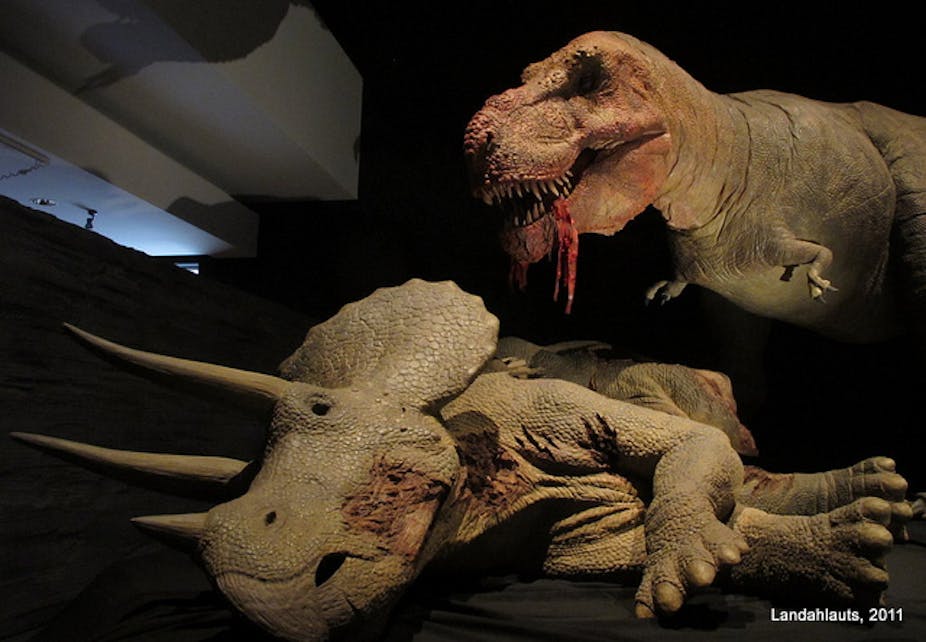Tyrannosaurux rex was a terrifying predator and not primarily a scavenger after all, according to researchers who analysed a crown tooth embedded in the tail of a lucky dinosaur that survived a T. rex attack.
The finding aims to settle a dispute among paleontologists, some of whom had previously argued that the T. rex diet was mainly comprised of meat scavenged from animal carcasses.
The study, published in the journal Proceedings of the National Academy of Sciences (PNAS), centred on a T. rex crown tooth that had become wedged between two tail vertebrae of a herbivore dinosaur called a hadrosaur.

The fact the tooth was embedded in the tail suggests the hadrosaur may have been fleeing when the attack occurred. The stuck tooth was surrounded by healed bone growth.
“This indicates that the prey escaped and lived for some time after the injury, providing direct evidence of predatory behaviour by T. rex,” the authors said in their paper.
Previous assertions that T. rex was exclusively a scavenger would require scientists to modify accepted reconstructions of the paleoecology to accommodate a scavenger of such significant proportions, the researchers said.
“The fact is, all of the evidence thus far used to argue that T. rex was a scavenger is all circumstantial and indirect, purely conjectural. This new specimen offers the best and most ironclad evidence that we could ever have hoped for, and it demonstrates with absolute certainty that a T.rex engaged a living hadrosaur,” said lead author Robert DePalma from Florida’s Palm Beach Museum of Natural History.
“This is an exciting new look at T. rex and its behaviour. The king has been re-crowned.”
Study co-author, David A. Burnham from the University of Kansas’ Division of Vertebrate Paleontology, said the finding showed that the giant carnivore must have been the apex predator during the Late Cretaceous period.
“Finding the tooth crown sent a chill down my spine, as I realised the monster depicted in Jurassic Park was real,” he said.

Smoking gun
John Long, Strategic Professor in Palaeontology at Flinders University, welcomed the new finding.
“What a stunning discovery. It’s extremely rare for fossils to reveal any information about the behaviour of prehistoric animals, but this new study by DePalma and colleagues in PNAS is a real smoking gun of firm evidence for predatory behaviour in the most iconic of all dinosaurs, Tyrannosaurus rex,” said Professor Long, who was not involved in the study.
“The specimen shows a fossilised tail bone of a hadrosaur that escaped alive after a skirmish with T.rex, with the predator’s tooth still stuck in its tail, proving beyond doubt T.rex hunted live and active prey. Speculation about it being purely a scavenger, as several well-known palaeontologist have suggested, now goes out the window.”
Professor Long said previous studies of fossil dung of large predators thought to be T. rex also have shards of hadrosaur bone through them.
However, despite the size of the fossil dung specimens strongly suggesting they belonged to T. rex, scientists were unable to say they were 100% sure the fossilised faeces were from Tyrannosaurus rex.
“Shards of bone in coprolites (fossil dung) only indicate what T. rex ate, not how it procured its food, which could have been by scavenging or hunting,” Professor Long said.

Mike Lee, a Senior Research Scientist and dinosaur expert at the University of Adelaide said that “as far as proving that T. rex engaged in predation, this evidence is as strong as we could get from a fossil.”
“It’s very difficult to prove predation in the fossil record using bite marks on prey bones - the identity of the biting animal can be difficult to ascertain, plus it’s even harder to prove whether it was the original predator or a scavenger that came along later,” said Dr Lee, who was not involved in the study.
“The new fossil is extraordinary in that a tooth is lodged in the wound (revealing the identity of the attacker as a T. rex) and the wound has healed (demonstrating that a living animal was attacked). As the paper stresses, most modern carnivores will opportunistically kill as well as scavenge, so while the new fossil proves that T. rex engaged in predation, it cannot rule out that it also scavenged some or even most of the time,” he said.
“I’d agree, and say direct fossil evidence for frequency of predation versus scavenging in T. rex would be almost impossible to obtain.”

